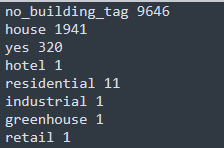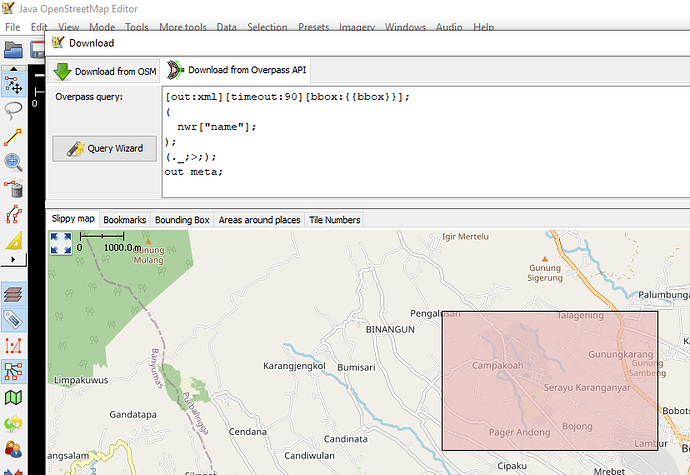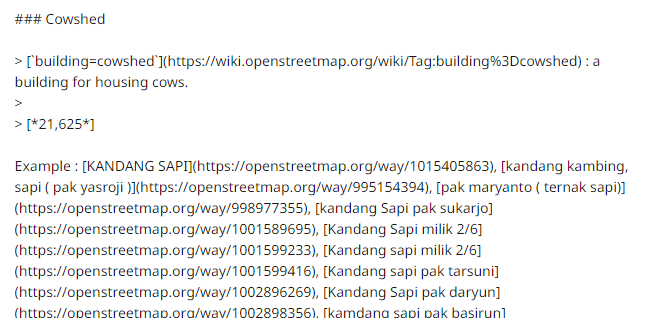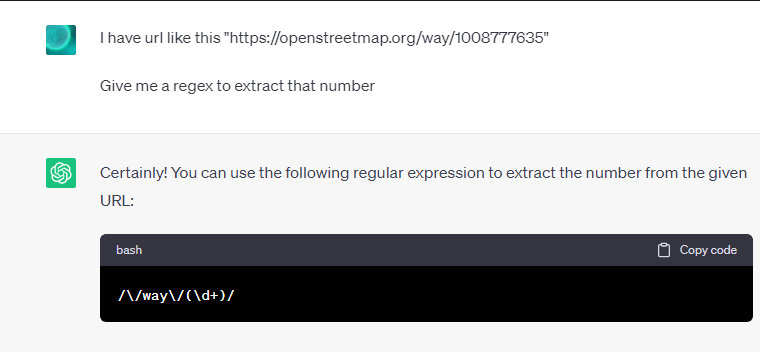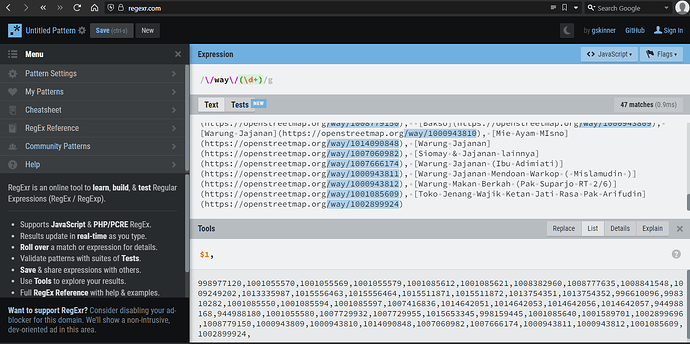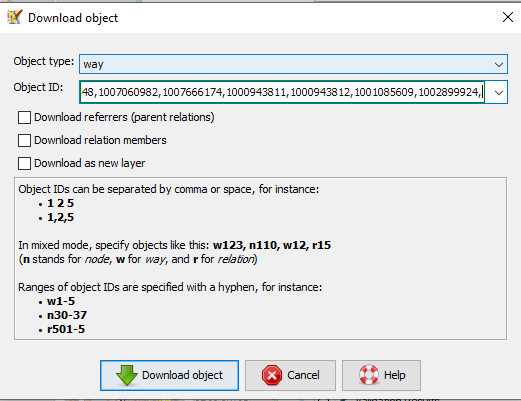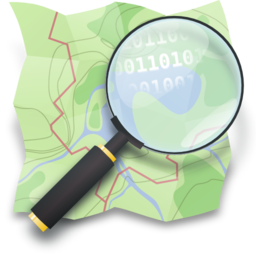campakoah_cleanup2.md
#### Adib Albadani ( 141 )
[BELUM ADA DRAINASE SEBELAH UTARA JALAN](https://openstreetmap.org/node/6547774037), [JALAN RUSAK DARI RUMAH PAK RT](https://openstreetmap.org/node/9364042457), [DIBANGUN RABAT BETON DARI PINGGIR RUMAH PAK YUDI](https://openstreetmap.org/node/9364042459), [BELUM ADA DRAINASE DARI RUMAH BARU](https://openstreetmap.org/node/9364042461), [DRAINASE KURANG BESAR DAN MAMPET](https://openstreetmap.org/node/9366783958), [kurang penerangan 1 atau 2](https://openstreetmap.org/node/9367811513), [penambahan talud sekitar 50 meter dari pos ronda menuju kolam](https://openstreetmap.org/node/9367811515), [diadakan irigasi disebelah sawah suksara](https://openstreetmap.org/node/9367811516), [Pabrik Porang (Pak Budi Bukan Asli Serla)](https://openstreetmap.org/way/905204971), [Peternak ayam (Hj.Musringah)](https://openstreetmap.org/way/905204977), [PUSKESMAS SERAYULARANGAN](https://openstreetmap.org/way/944988171), [PUSKESMAS SERAYULARANGAN](https://openstreetmap.org/way/944988172), [Balai Desa Serayularangan](https://openstreetmap.org/way/944988175), [SDN 1 SERAYULARANGAN](https://openstreetmap.org/way/944988178), [Sungai Kecil, DIBIKIN JALAN USAHA TANI](https://openstreetmap.org/way/994827469), [Irigasi](https://openstreetmap.org/way/994830930), [warung SEMBAKO (PAK HAMIDUN RT1/4) PENGEPUL GULA](https://openstreetmap.org/way/997341415), [KANDANG KAMBING](https://openstreetmap.org/way/998766584), [Kandang Kambing](https://openstreetmap.org/way/998766586), [PEDAGANG SEMBAKO (PAK DARMO)](https://openstreetmap.org/way/998959720), [WARUNG JAJANAN, KOPI](https://openstreetmap.org/way/998959723), [kolam lele kecil (PAK WARSONO)](https://openstreetmap.org/way/998959725), [PEDAGANG KELAPA DAN SAYURAN KELILING BELANJA DARI PASAR (PAK SARYO)](https://openstreetmap.org/way/998977117), [PRODUKSI SARAPAN KELILING (PAK SUPRI)](https://openstreetmap.org/way/998977120), [Kandang Kambing (PAK DARSONO)](https://openstreetmap.org/way/998977121), [Posko PP](https://openstreetmap.org/way/998995177), [gudang](https://openstreetmap.org/way/998995194), [kolam lele PEMBIBITAN (PAK SURYA)](https://openstreetmap.org/way/998995195), [Pos Ronda](https://openstreetmap.org/way/998995197), [KANDANG AYAM PETELOR KOSONG (PAK HAMIDUN)](https://openstreetmap.org/way/998995214), [lapangan bola serayularangan](https://openstreetmap.org/way/998995223), [SMPN 2 MREBET](https://openstreetmap.org/way/998995225), [PABRIK KAYU LAPIS](https://openstreetmap.org/way/998995226), [IBU RIHANAH (AYAM BAKAR,GORENG)](https://openstreetmap.org/way/1001055569), [PAK SUBANDRI (BAKSO,SOSIS BAKAR, MAINAN ANAK-ANAK)](https://openstreetmap.org/way/1001055570), [IBU WASIRAH](https://openstreetmap.org/way/1001055572), [PAK NURKHOLIK (KREDIT BARANG)](https://openstreetmap.org/way/1001055577), [IBU SUDIRAH (PEJUAL AREM-AREM)](https://openstreetmap.org/way/1001055579), [Warung Mie Ayam](https://openstreetmap.org/way/1001085612), [Warung Kelontong (Pak RT Kusworo)](https://openstreetmap.org/way/1001085618), [Penjual Pecel dan Rujak (Ibu Asminatun)](https://openstreetmap.org/way/1001085621), [RUKO KOSONG](https://openstreetmap.org/way/1007729946), [WARKOP](https://openstreetmap.org/way/1007729956), [Pembuat Tape (Pak Darsono)](https://openstreetmap.org/way/1007729978), [RT 1/4](https://openstreetmap.org/way/1008097225), [Kandang Kambing (Pak Suryono)](https://openstreetmap.org/way/1008382956), [Warung sembako](https://openstreetmap.org/way/1008382958), [Sarapan (PAK YUDI)](https://openstreetmap.org/way/1008382960), [MIYAGO (PAK TRIONO)](https://openstreetmap.org/way/1008382964), [Kadang Kambing (BU BADRIAH)](https://openstreetmap.org/way/1008777626), [PRODUKSI KERUPUK (IBU BADRIAH)](https://openstreetmap.org/way/1008777628), [WARUNG JAJANAN (PAK WANDI)](https://openstreetmap.org/way/1008777635), [Kandang Kambing (PAK GERI)](https://openstreetmap.org/way/1008777637), [Kandang Kambing (Pak Wartoni)](https://openstreetmap.org/way/1008779153), [KANDANG AYAM PEDAGING (PAK HASAN)](https://openstreetmap.org/way/1008790676), [KANDANG KAMBING (PAK SISWOYO)](https://openstreetmap.org/way/1008793792), [PENGRAJIN CONNECTOR MASKER (IBU SUNITAH)](https://openstreetmap.org/way/1008793800), [KANDANG KAMBING (PAK HAMIDUN)](https://openstreetmap.org/way/1008793803), [RUMAH PAK BANDI PENJUAL JAJANAN](https://openstreetmap.org/way/1008841528), [PETERNAK BURUNG MURAI](https://openstreetmap.org/way/1008841529), [KANDANG KAMBING (KOSONG)](https://openstreetmap.org/way/1008841531), [GUDANG](https://openstreetmap.org/way/1008841535), [PRODUKSI JAJANAN PASAR (PAK MARGITO)](https://openstreetmap.org/way/1008841541), [PENJUAL SEMBAKO (IBU SUYANTI WAHYONO)](https://openstreetmap.org/way/1008841544), [PENJUAL AYAM GORENG KELILING (IBU SULENI)](https://openstreetmap.org/way/1008841548), [SDN 1 SERAYULARANGAN](https://openstreetmap.org/way/1008847727), [PASAR LOHJINAWI](https://openstreetmap.org/way/1008847728), [BUMDES](https://openstreetmap.org/way/1008847729), [PESONA ALAM SERAYULARANGAN](https://openstreetmap.org/way/1008847730), [Warung Seblak](https://openstreetmap.org/way/1009249202), [Kandang Kambing (Kosong) (Pak Sunaidin)](https://openstreetmap.org/way/1009249207), [RUMAH PENGEPUL GULA JAWA](https://openstreetmap.org/way/1009249210), [Kandang kambing](https://openstreetmap.org/way/1009249213), [PABRIK PRODUKSI GULA](https://openstreetmap.org/way/1009249214), [IBU SITI AMALIAH (PENJUAL JAJANAN KUE)](https://openstreetmap.org/way/1013335987), [Pertashop](https://openstreetmap.org/way/1014392383), [JAMBU KRISTAL,PEPAYA](https://openstreetmap.org/way/1014392385), [KAMBING](https://openstreetmap.org/way/1014392386), [penjual Boba](https://openstreetmap.org/way/1014392387), [Kandang kambing (Pak Ahmad Suwanto)](https://openstreetmap.org/way/1014392394), [WARUNG SEMBAKO](https://openstreetmap.org/way/1015034043), [Kandang kambing](https://openstreetmap.org/way/1015081654), [Kandang kambing](https://openstreetmap.org/way/1015081656), [Kandang Kambing (Pak Munarso)](https://openstreetmap.org/way/1015081657), [Kandang kambing](https://openstreetmap.org/way/1015081658), [Kandang Kambing](https://openstreetmap.org/way/1015081659), [Kandang Kambing](https://openstreetmap.org/way/1015081662), [Kolam Pemijahan Ikan Lele](https://openstreetmap.org/way/1015081663), [Kolam Pembesaran Ikan Lele](https://openstreetmap.org/way/1015081664), [Kolam Pembesaran Ikan Lele](https://openstreetmap.org/way/1015081665), [Kolam Pembesaran Ikan Lele (Pak Yudi Warsono)](https://openstreetmap.org/way/1015081666), [Kolam Pembesaran Ikan Lele](https://openstreetmap.org/way/1015081667), [Kolam Pembesaran Ikan Lele](https://openstreetmap.org/way/1015081668), [Pembesaran Kolam Ikan Lele](https://openstreetmap.org/way/1015081669), [Pembesaran Kolam Ikan Hias (Pak Dasiman)](https://openstreetmap.org/way/1015081670), [Kolam Pembesaran Ikan Lele (Pak Toto)](https://openstreetmap.org/way/1015081671), [GUDANG KAYU](https://openstreetmap.org/way/1015081672), [KANDANG AYAM (PAK HASAN)](https://openstreetmap.org/way/1015405862), [KANDANG SAPI](https://openstreetmap.org/way/1015405863), [KANDANG KAMBING (PAK HAMIDUN)](https://openstreetmap.org/way/1015405864), [KANDANG KAMBING (PAK YUDI)](https://openstreetmap.org/way/1015405865), [KANDANG KAMBING (PAK SYARIFUDIN)](https://openstreetmap.org/way/1015405866), [KOLAM IKAN MUJAIR, BAWAL (PAK HAMIDUN)](https://openstreetmap.org/way/1015405867), [KOLAM IKAN LELE (PAK HASAN)](https://openstreetmap.org/way/1015405868), [KOLAM IKAN LELE (PENGELOLA PONDOK)](https://openstreetmap.org/way/1015405869), [KOLAM IKAN LELE (PAK RISMAN)](https://openstreetmap.org/way/1015405870), [KOLAM IKAN LELE (PAK RT)](https://openstreetmap.org/way/1015405871), [KOLAM IKAN LELE (PAK YUSWERI)](https://openstreetmap.org/way/1015405872), [KOLAM BIBIT LELE (PAK KASRUDIN)](https://openstreetmap.org/way/1015405873), [TOKO SEMBAKO](https://openstreetmap.org/way/1015405874), [PENJUAL SAYUR KELILING (PAK SIRIN)](https://openstreetmap.org/way/1015405875), [WARUNG JAJANAN (IBU SISWOYO)](https://openstreetmap.org/way/1015405876), [WARUNG GORENGAN (IBU SUNANI)](https://openstreetmap.org/way/1015405877), [RT 2/4](https://openstreetmap.org/way/1015431316), [KANDANG KAMBING (PAK SYAHRONI](https://openstreetmap.org/way/1015556440), [KANDANG KAMBING (PAK PARYO)](https://openstreetmap.org/way/1015556441), [KANDANG KAMBING (PAK SARKAM)](https://openstreetmap.org/way/1015556442), [KOLAM IKAN GURAME](https://openstreetmap.org/way/1015556443), [KOLAM IKAN LELE (PAK SUTIRNO)](https://openstreetmap.org/way/1015556444), [KOLAM IKAN KONSUMSI MUJAIR, GURAME(PAK YUSUF)](https://openstreetmap.org/way/1015556445), [KOLAM IKAN KONSUMSI MUJAIR, NILA (PAK SUNARYO)](https://openstreetmap.org/way/1015556446), [KOLAM (KOSONG)](https://openstreetmap.org/way/1015556447), [KOLAM IKAN LELE (PAK FITRIANTO)](https://openstreetmap.org/way/1015556448), [KOLAM IKAN KONSUMSI (PAK SUPANDI)](https://openstreetmap.org/way/1015556449), [KOLAM KONSUMSI IKAN MUJAIR (PAK DARMANTO)](https://openstreetmap.org/way/1015556450), [KOLAM KONSUMSI IKAN LELE (PAK SARYO)](https://openstreetmap.org/way/1015556451), [KOLAM IKAN LELE (PAK NARYO,SRI)](https://openstreetmap.org/way/1015556452), [KOLAM KONSUMSI MUJAIR(PAK WANDI)](https://openstreetmap.org/way/1015556453), [ENTOG (PAK EDI SUKAMTO)](https://openstreetmap.org/way/1015556454), [KANDANG ENTOG (PAK WARSONO)](https://openstreetmap.org/way/1015556455), [KANDANG ENTOG (PAK DWI)](https://openstreetmap.org/way/1015556456), [KANDANG ENTOG (PAK WINARDIN)](https://openstreetmap.org/way/1015556457), [KANDANG ANGSA (PAK SUPANDI)](https://openstreetmap.org/way/1015556458), [KANDANG AYAM BANGKOK TERNAK (PAK NENDRO)](https://openstreetmap.org/way/1015556459), [KANDANG AYAM BANGKOK TERNAK (PAK SUBEKTI))](https://openstreetmap.org/way/1015556460), [KANDANG AYAM BANGKOK TERNAK (PAK SUPANDI)](https://openstreetmap.org/way/1015556461), [WARUNG MAKANAN DAN JAJANAN (PAK RASTAM)](https://openstreetmap.org/way/1015556462), [GUDANG RT 2/4, TEMPAT JUAL JAJANAN PASAR SERABI (IBU KUSPRATINAH)](https://openstreetmap.org/way/1015556463), [WARUNG JAJANAN (IBU MUNIROH)](https://openstreetmap.org/way/1015556464), [irigasi mati](https://openstreetmap.org/way/1015556465), [irigasi mati](https://openstreetmap.org/way/1015556467),
#### Muhammad Hendrick Sedayu ( 106 )
[perlu penerangan yg terang](https://openstreetmap.org/node/9184899966), [Plang4 (1/3,3/1,2/2)](https://openstreetmap.org/node/9354864757), [Serayularangan](https://openstreetmap.org/node/9365326017), [PERBAIKAN JALAN](https://openstreetmap.org/node/9378474202), [SAMPAH DISELOKAN](https://openstreetmap.org/node/9389005168), [BANJIR KARENA SAMPAH](https://openstreetmap.org/node/9389005169), [DRAINASE MINTA DIPERBESAR (1)](https://openstreetmap.org/node/9389005170), [TALUD SEPANJANG JALAN WISATA](https://openstreetmap.org/node/9389005171), [drainase rusak +- 50 m barat jalan karena taludnya rusak](https://openstreetmap.org/node/9404334750), [plan gudang RT](https://openstreetmap.org/node/9404334751), [dibuat jalan tapi belum dapet ijin dari pemilik tanah](https://openstreetmap.org/node/9404334752), [butuh penerangan](https://openstreetmap.org/node/9406756361), [butuh penerangan](https://openstreetmap.org/node/9406756362), [butuh penerangan](https://openstreetmap.org/node/9406756363), [butuh penerangan](https://openstreetmap.org/node/9406756364), [butuh penerangan](https://openstreetmap.org/node/9406756365), [butuh penerangan (2)](https://openstreetmap.org/node/9406756366), [drainase kiri belum adaa, kanan rusak](https://openstreetmap.org/node/9406756367), [tiang listrik kurang 3](https://openstreetmap.org/node/9406756368), [butuh talud sepanjang jalan utama](https://openstreetmap.org/node/9406756369), [PAK SUHRI](https://openstreetmap.org/way/947585966), [Bu Lani (Reseller Gula)](https://openstreetmap.org/way/949542486), [Terusan](https://openstreetmap.org/way/994312693), [PAK SATIRUN](https://openstreetmap.org/way/997820826), [PAK SLAMET](https://openstreetmap.org/way/997820964), [PAK SUDIYARTO](https://openstreetmap.org/way/998287063), [PAK TEGUH](https://openstreetmap.org/way/998287065), [PAK RT](https://openstreetmap.org/way/998287316), [PAK KUAT](https://openstreetmap.org/way/998288324), [PAK KADES](https://openstreetmap.org/way/998288528), [RT 2/6](https://openstreetmap.org/way/1001291107), [Gudang kayu PAK SUDARNO 1/6](https://openstreetmap.org/way/1001296721), [Warung merah PAK SANSURI](https://openstreetmap.org/way/1001298610), [Warung Pink](https://openstreetmap.org/way/1001303237), [RT 3/6](https://openstreetmap.org/way/1001326934), [PAK NARKO](https://openstreetmap.org/way/1001336103), [PAK ABDUS SOMAD](https://openstreetmap.org/way/1001336110), [Mushola miftaahul falaah](https://openstreetmap.org/way/1007416825), [Kolam kosong](https://openstreetmap.org/way/1007419493), [Kambing pak sukirman](https://openstreetmap.org/way/1007419495), [UMKM Bu Wati](https://openstreetmap.org/way/1007419499), [Penggilingan Tepung dan Kopi (Pak Sutarmo)](https://openstreetmap.org/way/1007507472), [Toko Afif Snack](https://openstreetmap.org/way/1007507474), [Toko & Seblak N'angkring (Bu Miswati)](https://openstreetmap.org/way/1007507476), [Kambing pak samyudi](https://openstreetmap.org/way/1007507480), [Kambing pak jarwoto](https://openstreetmap.org/way/1007507487), [Cabut Bulu Udi Berkah (Pak Widiyano) Pedagang](https://openstreetmap.org/way/1007507494), [Penjual Pupuk Pak Kripto](https://openstreetmap.org/way/1007507502), [Toko Sembako Pak Sarno](https://openstreetmap.org/way/1007701249), [Kambing pak wasirun](https://openstreetmap.org/way/1007701254), [Serbuk Kayu Pak Gustiawan](https://openstreetmap.org/way/1007701259), [Pemesanan Roti Untuk acara Bu Riswanti](https://openstreetmap.org/way/1007701264), [Penjahit Bu Minarsih](https://openstreetmap.org/way/1007701269), [Penjual Pupuk Pak Sutiman](https://openstreetmap.org/way/1007701274), [Kambing pak sudiarso](https://openstreetmap.org/way/1007701275), [kambing pak karnanto](https://openstreetmap.org/way/1007701276), [Penjual Pupuk Pak Sarmo](https://openstreetmap.org/way/1007701279), [Sungai](https://openstreetmap.org/way/1008092487), [RT 3/1](https://openstreetmap.org/way/1013335988), [RT 1/1](https://openstreetmap.org/way/1014392382), [PAK SLAMET](https://openstreetmap.org/way/1017814790), [KAMBING PAK SURDIYATO](https://openstreetmap.org/way/1017814791), [PAK SOHRIB](https://openstreetmap.org/way/1017814792), [PAK SAMSURI](https://openstreetmap.org/way/1017814793), [IKAN LELE DUMBO](https://openstreetmap.org/way/1017814794), [TERNAK IKAN PAK SUHRI](https://openstreetmap.org/way/1017814795), [IKAN PAK MARYONO LELE DUMB](https://openstreetmap.org/way/1017814797), [IKAN PAK KADUS lele dumbo](https://openstreetmap.org/way/1017814798), [IKAN PAK KADUS mujahir](https://openstreetmap.org/way/1017814799), [PAK MEMET WARUNG](https://openstreetmap.org/way/1017814800), [SAYU BU ERNAWATI](https://openstreetmap.org/way/1017814801), [SAYUR, RAMES BU SUKIMAH](https://openstreetmap.org/way/1017814803), [PAK WAHONO](https://openstreetmap.org/way/1017814804), [ikan](https://openstreetmap.org/way/1017914414), [ikan](https://openstreetmap.org/way/1017914415), [ikan](https://openstreetmap.org/way/1017914416), [kolam ikan mujahir pak kades](https://openstreetmap.org/way/1017914417), [kolam ikan lele dumbo pak sadirun](https://openstreetmap.org/way/1017914418), [ikan lele pak saeful rohman](https://openstreetmap.org/way/1017914419), [bu tasni](https://openstreetmap.org/way/1017914420), [las pak warmopno](https://openstreetmap.org/way/1017914421), [bu musringah](https://openstreetmap.org/way/1017914422), [JUAL SAYUR BU ERNAWATI](https://openstreetmap.org/way/1017914423), [PRODUKSI KOPI BU SUHANTI](https://openstreetmap.org/way/1017914424), [PRDUKSI KUE BU NURUL KHOMARIAH](https://openstreetmap.org/way/1017914425), [ERVICE ELEKTRONIK PAK ARIFIN](https://openstreetmap.org/way/1017914426), [GO JEK PAK SUKIRNO](https://openstreetmap.org/way/1017914427), [OJEK PENGKOLAN MAS JOKO](https://openstreetmap.org/way/1017914428), [JUAL SAYUR BU JARIYAH](https://openstreetmap.org/way/1017914429), [PENGRAJIN BAMBU PAK SETYO](https://openstreetmap.org/way/1017914430), [FURNITURE PAK MUSLIHIN](https://openstreetmap.org/way/1017914431), [PENGRAJIN KANDANG PAK SOHRIB](https://openstreetmap.org/way/1017914432), [PORANG PAK SODIRUN](https://openstreetmap.org/way/1017914433), [OLAHAN MAKANAN SINGKONG BU ROSIDAH](https://openstreetmap.org/way/1017914434), [Sungai](https://openstreetmap.org/way/1019654104), [Sungai](https://openstreetmap.org/way/1019654105), [kambing pak rusno](https://openstreetmap.org/way/1019920284), [kambing pak karso sasmoyo](https://openstreetmap.org/way/1019920285), [kambing pak karso sasmoyo](https://openstreetmap.org/way/1019920286), [kambing pak karnanto](https://openstreetmap.org/way/1019920287), [kambing pak rasmudin](https://openstreetmap.org/way/1019920288), [kambing pak misroni](https://openstreetmap.org/way/1019920289), [kambing pak wahyono](https://openstreetmap.org/way/1019920290), [kambing pak kusmono](https://openstreetmap.org/way/1019920291), [produksi jajanan pasar](https://openstreetmap.org/way/1019920292), [produksi snack](https://openstreetmap.org/way/1019920293),
#### Addinul ( 89 )
[RT2/5,3/5,1/5](https://openstreetmap.org/node/6547774029), [Plang8 (RW4,Telaga,RW5,2/6,3/6,lapvoli, RT1/4,RT1/6](https://openstreetmap.org/node/6547774036), [penerangan rusak](https://openstreetmap.org/node/6547778889), [Plang 6(2/3,3/3,RW 4)](https://openstreetmap.org/node/8900114304), [jalan rusak](https://openstreetmap.org/node/8900143370), [jalan rusak](https://openstreetmap.org/node/9183615364), [Plang7 (Telaga,Baldes,Ponpesk,RW 6)](https://openstreetmap.org/node/9207021353), [Plang (masjid)](https://openstreetmap.org/node/9354864754), [Plang 2 (Baldes,TK,1/1,2/1,SDN 2 Serla, Puskesmas, Bumdes)](https://openstreetmap.org/node/9354864755), [Plang 3(Campakoah,,1/2,2/2)](https://openstreetmap.org/node/9354864756), [Plang6 (2/2,1/2,Masjid Sabilurohman,RW 3)](https://openstreetmap.org/node/9354864758), [Plang10(Lap voli,senggol,2/4,3/4)](https://openstreetmap.org/node/9354864759), [penerangan rusak](https://openstreetmap.org/node/9355908372), [penerangan rusak](https://openstreetmap.org/node/9355908373), [TPQ](https://openstreetmap.org/way/882484726), [Pondok Corner Fashion](https://openstreetmap.org/way/882484733), [Tempat Pengerajin](https://openstreetmap.org/way/882484736), [pak sarmanto ( jual sayur keliling )](https://openstreetmap.org/way/882484740), [Pak Kartoyo(Penderes)](https://openstreetmap.org/way/882484742), [bu kasmini ( jiwel kriyik )](https://openstreetmap.org/way/882484745), [bu rudiah ( jamu gendong)](https://openstreetmap.org/way/882484748), [sanggar senam queen corner , toko onderdil (ali mustafa )](https://openstreetmap.org/way/882484750), [jasuke( kholilullah )](https://openstreetmap.org/way/952256655), [tokobuah ( pak turyono )](https://openstreetmap.org/way/952256656), [kandang ayam](https://openstreetmap.org/way/952256657), [bengkel mobil timin](https://openstreetmap.org/way/952256661), [Masjid Sabillurohman](https://openstreetmap.org/way/952257734), [Mushola](https://openstreetmap.org/way/952257735), [conter hp ( pak holidin )](https://openstreetmap.org/way/952257736), [Mas Agus (Penjual Snack Pesanan)](https://openstreetmap.org/way/952257737), [toko lampu ( nurwandi ) dan instalasi](https://openstreetmap.org/way/952257738), [keripik pisang ( mas hamid ), penjualan sampai purbalingga, ternak Lele](https://openstreetmap.org/way/993615778), [kandang kambing, sapi ( pak yasroji )](https://openstreetmap.org/way/995154394), [produksi teh jawa ( pak sahyuni ), ternak lele](https://openstreetmap.org/way/995154396), [keripik tempe ( pak nasir), penjualan supermarket, penjualan sekitar purbalingga](https://openstreetmap.org/way/995154399), [pengrajin sapu gelaga ( pak amam faturahman), expor keluar jawa, penjual ikan, kebun kapulaga](https://openstreetmap.org/way/995154402), [ternak kambing ( pak mirsono )](https://openstreetmap.org/way/996823006), [ternak lele ( Pak edi purnomo )](https://openstreetmap.org/way/996823008), [pak warmudin ( kandang kambing )](https://openstreetmap.org/way/996823013), [Pak sudardi ( ternak kambing )](https://openstreetmap.org/way/996823018), [Industri kayu ( pak han su )hensu](https://openstreetmap.org/way/997508714), [Sungai](https://openstreetmap.org/way/997678844), [Pak Mustofir (Penjual Ikan termasuk Laut)](https://openstreetmap.org/way/998317009), [Ikan Mujair ( Pak wismanto )](https://openstreetmap.org/way/998323021), [Kolam Lele ( Pak kusmidi )](https://openstreetmap.org/way/998977344), [pak anton ( penjual ikan )](https://openstreetmap.org/way/998977349), [pak narmudin ( ternak ikan )](https://openstreetmap.org/way/998977352), [pak maryanto ( ternak sapi)](https://openstreetmap.org/way/998977355), [Kandang Kambing ( muswanto )](https://openstreetmap.org/way/998978683), [mie ayam bakso ( pak syarif )](https://openstreetmap.org/way/999028751), [singkong](https://openstreetmap.org/way/999028752), [Kelapa](https://openstreetmap.org/way/999028758), [Kelapa](https://openstreetmap.org/way/999028759), [Bu Tohirin (ubur Sumsumkeliling)](https://openstreetmap.org/way/1001062983), [cabe Bu Musrifah](https://openstreetmap.org/way/1001318574), [cabe Pak Sugeng Rianto](https://openstreetmap.org/way/1001318577), [Jalan Perbatasan sangkanayu](https://openstreetmap.org/way/1005114693), [Pak Prianto (Penderes)](https://openstreetmap.org/way/1005114702), [Wilayah RT 2/3](https://openstreetmap.org/way/1007159051), [Bengkel Ikbal Zaki motor](https://openstreetmap.org/way/1009069268), [PT Bulumata (PakHermawan)(20 karyawan )](https://openstreetmap.org/way/1009069269), [Pak Karyoto (Penderes)](https://openstreetmap.org/way/1009069274), [empang lele Psk Mistarto](https://openstreetmap.org/way/1009069275), [kandang kambing](https://openstreetmap.org/way/1009069277), [Pak Kusprianto(Penderes)](https://openstreetmap.org/way/1009069279), [rumah kosong](https://openstreetmap.org/way/1009069284), [BRI Link](https://openstreetmap.org/way/1009097299), [kebun nanas Pak Nurcahyono](https://openstreetmap.org/way/1009207857), [kandang kambingpaksarmanto](https://openstreetmap.org/way/1009207862), [kebun nanas Pak Nurcahyono](https://openstreetmap.org/way/1009234379), [warung jajanan kelontong lengkap alat listrik (](https://openstreetmap.org/way/1009234380), [Musholla 3/4](https://openstreetmap.org/way/1009249200), [Pak Jami'in (Penderes)](https://openstreetmap.org/way/1012204889), [Kandangkambingpakkusrianto](https://openstreetmap.org/way/1015511861), [Paktohirinkambing](https://openstreetmap.org/way/1015511862), [pakrusmonokambing](https://openstreetmap.org/way/1015511863), [pakmuhidin](https://openstreetmap.org/way/1015511864), [pakslametrianto](https://openstreetmap.org/way/1015511865), [pakasrohalribut](https://openstreetmap.org/way/1015511866), [Pakmursholeh(kambig)](https://openstreetmap.org/way/1015511867), [Pak Saiful Mustakim (Kolam Ikan Lele)](https://openstreetmap.org/way/1015511868), [Kolam Lele Pak](https://openstreetmap.org/way/1015511869), [PakSutiman (Penderes)](https://openstreetmap.org/way/1015511870), [pak rohiman ( bakso bakar )](https://openstreetmap.org/way/1015511871), [nursholeh ( kupat gorengan lontong )](https://openstreetmap.org/way/1015511872), [penerangan](https://openstreetmap.org/way/1015511873), [penerangan](https://openstreetmap.org/way/1015511874), [penerangan](https://openstreetmap.org/way/1015511875), [banjir jika drainase tidak ada](https://openstreetmap.org/way/1015511878),
#### Julianpratama ( 68 )
This file has been truncated. show original
